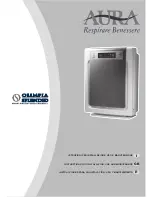
23
English
Ins
tallation Pr
oc
edur
e
8
Check for gas leakage.
• At this time, especially check for gas leakage from
the 3-way valve’s stem nuts(A port), and from the
service port cap.
CAUTION
• Connect the indoor and outdoor units using pipes
with flared connections (not supplied). For the lines,
use insulated, unwelded, degreased and deoxidized
copper pipe, (Cu DHP type to ISO 1337 or UNI EN
12735-1), suitable for operating pressures of at least
4200 kPa and for a burst pressure of at least 20700
kPa. Copper pipe for hydro-sanitary applications is
completely unsuitable.
• For sizing and limits (height difference, line length,
max. bends, refrigerant charge, etc.) see “Connecting
refrigerant pipe section”.
Step 9 Adding refrigerant (R-32)
Precautions on adding the R-32 refrigerant
In addition to the conventional charging procedure, the
following requirements shall be kept.
• Make sure that contamination by other refrigerants
does not occur for charging.
• To minimize the amount of refrigerant, keep the
hoses and lines as short as possible.
• The cylinders shall be kept upright.
• Make sure that the refrigeration system is earthed
before charging.
• Label the system after charging, if necessary.
• Extreme care is required not to overcharge the
system.
• Before recharging, the pressure shall be checked with
nitrogen blowing.
• After charging, check for leakage before
commissioning.
• Be sure to check for leakage before leaving the work
area.
• The outdoor unit is loaded with sufficient refrigerant
for the standard piping. Thus, refrigerant must be
added if the piping is lengthened. This operation
can only be performed by a qualified refrigeration
specialist. To determine the quantity of refrigerant
charge, see
Calculating the quantity of refrigerant to
add
on page
25
.
1
Check if the stop valve is closed completely.
2
Charge the refrigerant through the service port of the
liquid stop valve.
NOTE
• Do not charge the refrigerant through the service
port of the gas stop valve.
3
If you have any difficulty charging the refrigerant as
described in the steps above, take the following steps:
a
Open the liquid stop valve and gas stop valve.
b
Operate the air conditioner by pressing the K2
key on the outdoor unit PCB.
c
After about 30 minutes, charge the refrigerant
through the service port of the gas stop valve.
Indoor Unit
Outdoor Unit
Liquid side stop valve(service port)
Gas side stop valve(service port)
Balance
Ref
Vacuum
pump
Important information: regulation regarding the
refrigerant used
This product contains fluorinated greenhouse gases. Do
not vent gases into the atmosphere.
CAUTION
• Inform user if the system contains 5 tCO
2
e or more of
fluorinated greenhouse gases. In this case, it must be
checked for leakage at least once every 12 months,
according to regulation No. 517/2014. This activity
must be covered by qualified personnel only.
• In the case of the situation above, the installer (or
authorized person with responsibility for final check)
must provide a maintenance book, with all the
information recorded, according to REGULATION (EU)
No. 517/2014 OF THE EUROPEAN PARLIAMENT AND
OF THE COUNCIL of 16 April 2014 on fluorinated
greenhouse gases.
















































